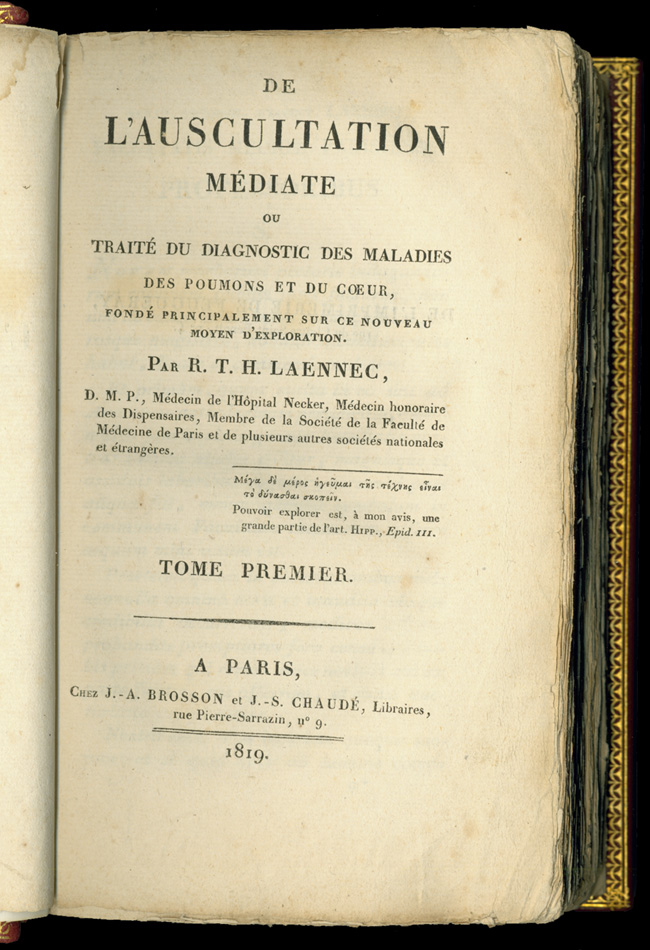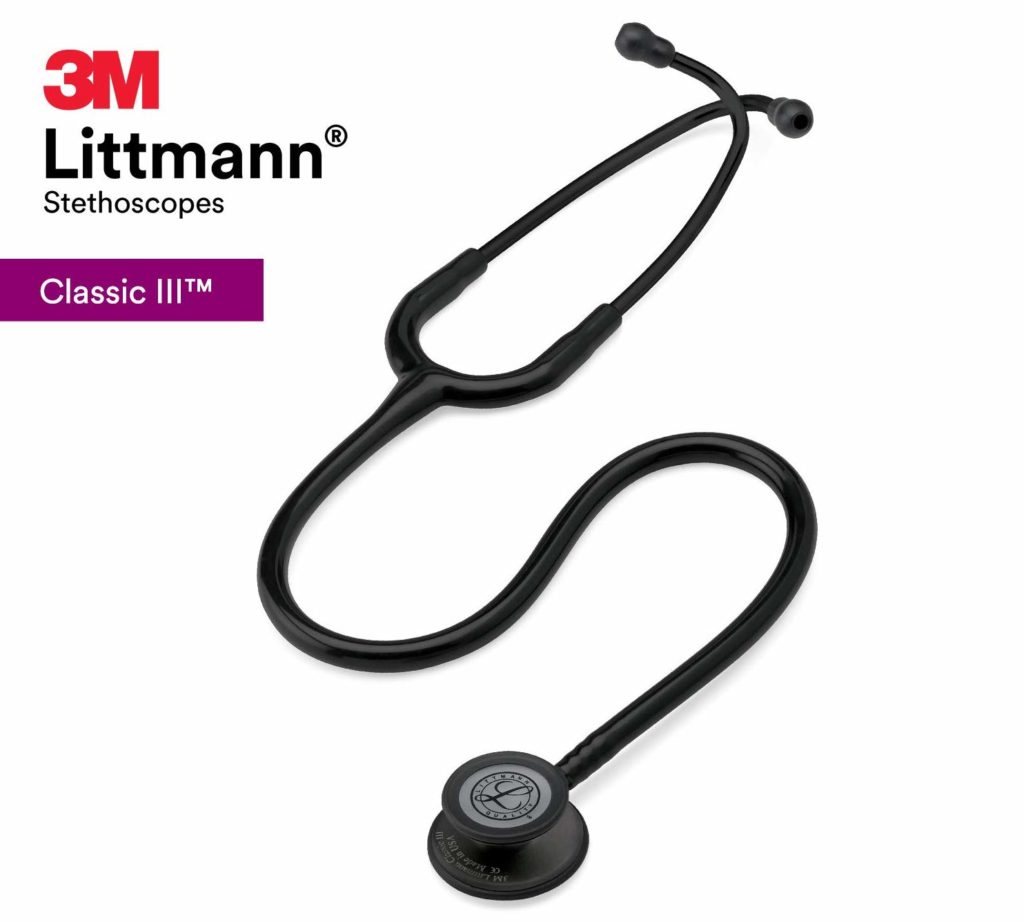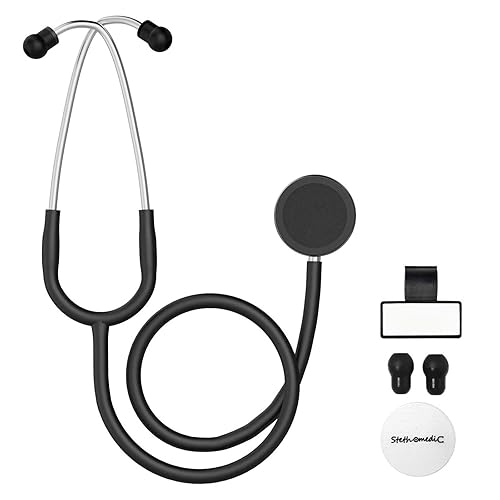Among the many tools and gadgets associated with the medical field, few are more thought-of than the stethoscope. From children’s toys of playing doctor to icons of jewelry for nurses to the go-to look for medical professionals, the stethoscope is a foundational instrument to helping people be well.
But just what makes stethoscopes so important to just about every exam or check-up? With such popularity and variety of uses of such device, there’s a lot of different options to choose from. From your head to your toes, a stethoscope can make a significant difference in the medical professional’s ability to discover and address your health and pinpoint any issues quickly.
Whether you’re just starting out in the medical field, are looking for a new option from your current instrument or are curious about using one for your own health and wellness, stethoscopes can be helpful resources for all. We’re here to help you get started in choosing the stethoscope that will fit exactly what you’re looking for. Next, we share what you need to know about all things stethoscopes. From their variety of uses to the different types to what you should be looking for in making your selection, we’ve got it here for you. Here we also share some of the top picks for stethoscopes based on where you’re at in your medical career or specific characteristics you’re looking for in your instrument.
What is a Stethoscope?
When it comes to one of the most useful and versatile instruments a doctor or nurse has, the stethoscope rises to the top. The word “stethoscope” comes from two Greek words that mean chest and examination. Yet beyond the chest, a stethoscope can be used for a variety of areas of the body.
The stethoscope typically has two tubes that are connected to earpieces that can fit in the administrator’s ears. These tubes are also connected to a small circular resonator made of metal.
History of Stethoscopes
As its name implies, the stethoscope really began with an emphasis on the chest and heart. As the heart is an internal organ and can’t be seen just on the outside, knowing the sound of the heart was shown to be a valuable source of information in determining the health of the individual.

Even before the version of a stethoscope of what we recognize today came to be, physicians have been interested and involved in identifying and tracking sounds of the chest and heart. American Diagnostic Corporate notes that physicians would use things such as auscultation, which is where they put their ear directly on the patient’s chest to hear the sounds inside. This attention to sound could help the physician use percussion and rhythm to identify any concerns. However, this direct contact between the physician and patient proved problematic in several regards. As a result, there came the demand for an instrument where the physician could still get that audible information without error-prone direct contact.
As a result, doctor René-Théophile-Hyacinthe Laennec developed the first stethoscope in 1816. The method he used allowed him to hear the heart sounds even more clearly and eased the process greatly. As other physicians found this practice valuable, the stethoscope continued to develop and advance in technology with improvements like adding two earpieces in a bi-aural method as it became a standard diagnostic instrument.
Over time, technology has continued to improve the function and ease of use of the stethoscope. Things like lightening the weight and improving the quality of sounds have made it a versatile and essential instrument for all physicians. Since its beginnings, this device has had a profound influence in equipping physicians with the opportunity to hear the internal operations of a patient without intruding space or drawing inerrant conclusions.
Parts of a Stethoscope
The design and function of the stethoscope has come a long way since it was first invented. Today’s model has several components that each serve a purpose in the practice of auscultation. According to Inside PA Training, the stethoscope has a few key parts that allow the physician to effectively listen to the patient’s organs or other areas.
The physician most often will wear the stethoscope around his or her neck when not in use. When using, he or she will put the eartips in the ears, which is connected to the eartube and tubing that is connected to the chestpiece.

One of the key pieces of the chestpiece is the diaphragm. This is the disc-like flat piece that is placed on the patient’s body. The other side of the bell, which is also round and has a smaller piece with a whole. Turning these two pieces allows the physician to adjust the settings to be more effective. According to Inside PA Training, the diaphragm portion works better in situations where high pitched sounds are heard, such as in normal heart beating or breathing. The bell side may be better for detecting sounds that have a lower pitch, such as murmurs or bowel movements.
This diaphragm piece is what vibrates when the patient’s internal processes make noise. This vibration moves the air inside the tube, which moves the air in and out of the ears of the physician. The sound is amplified by the stethoscope as the diaphragm has a greater surface area than the column of air in the tube. That air must move further in the diaphragm to cause pressure waves that are heard by the physician.
Another more innovative use of the stethoscope is being able to measure the span of the liver. Using sound, the physician can determine the location of the liver to identity any concerns.
What are Stethoscopes Used For?
Since the earliest models, stethoscopes have been designed to be able to hear the rhythm or other internal processes for patients. Most often, stethoscopes are used to listen to internal organs such as the heart, lungs or intestines. Being able to identify sounds made by these organs provide helpful information
Another very common use for the stethoscope is measuring blood pressure. This may be what is most often associated with the stethoscope in a regular check-up, aside from listening to organs. Using a blood pressure cuff, the physician can place the stethoscope on the vein of the patient to determine the diastolic blood pressure.
Who Needs a Stethoscope?
From experienced cardiologists to nursing students, those in the medical field will most likely need quick and easy access to their own stethoscope. As a trademark of the occupation, the stethoscope is a highly versatile tool that is helpful in a variety of settings and conditions.
Stethoscopes come in a variety of types that can incorporate features based on who is using them. Cardiologists may require a more advanced version of a stethoscope than a general practitioner who’s helping a patient in a general check-up.
How to Clean a Stethoscope
Because of their high involvement in hospitals, doctors’ offices and other medical areas, cleaning your stethoscope is an important practice to get into the habit of. In fact, My PA Training notes that stethoscopes may be involved in transferring patient-to-patient diseases. Prevent that harmful transmission by wiping the chest piece with a disinfecting wipe that has an alcohol component.
Other ways to care for your stethoscope include keeping it away from extreme temperatures or immersing it in liquid. You can also preserve the earpieces by removing any debris or gunk from them as needed. If possible, transport your stethoscope in a case when not in use.
Getting into the habit of cleaning and preserving your stethoscope with antibacterial wipes and other cleaners can help you preserve your instrument as well as keep yourself and all you come in contact with safe from transmitting diseases.
How Long Does a Stethoscope Last
The durability and life of your stethoscope are often dependent on the frequency of use and the quality of the material used in it. According to DS Medical, the typical stethoscope lasts about just two years. This timeframe may depend based on the frequency of use and how well you care for it.

When to Replace Your Stethoscope
Unfortunately, stethoscopes don’t last forever. If you notice that your stethoscope is giving inaccurate readings or it comes more difficult to hear sounds, it may be time to find a new version.
Other signs that indicate a replacement is needed is when the tubing of your stethoscope becomes hardened. This is because the PVC material in your stethoscope comes into frequent contact with the skin. One way to prevent this is by keeping the stethoscope away from skin contact when it’s not being used.
Sometimes, stethoscopes may just need a quick repair. This may be helpful for more expensive versions like digital ones. Also, you may also be able to just replace the earpieces of your stethoscope, as those are one of the first components to show wear and tear. Finding replacement earpieces is easily done online. Replacing just the earpieces rather than the entire unit can be a more affordable option than having to get an entirely new stethoscope.
Types of Stethoscopes
With their variety of uses and purposes, stethoscopes come in a wide range of types, each with features and styles that are tailored to meet the individual’s preferences. You can find them at all price ranges, depending on your quality requirements. When it comes to different types of stethoscopes, there are two main versions that can both be effective in amplifying sounds for physicians to hear.
Acoustic Stethoscopes – These types of stethoscopes are designed to send more sound waves to the physician’s ears. Being able to hear those vibrations is what helps the physician make informed decisions. Using this amplification method, the sound waves are more easily heard and the process is more effective.
Electronic Stethoscopes – These varieties amplify the internal sounds even more than an acoustic version. They use electronic signals to optimize the sounds for listening. These digital versions may also come with a variety of other features that can be of particular value to cardiologists or those who use them on a regular basis.
In addition to different types of stethoscopes, the headpieces of stethoscopes may also vary based on the use. For example, there are specific types of stethoscopes designed for cardiology, for pediatric, for veterinary and for some other uses as well. Each of these designed types have particular features that better help to meet the needs of the specific patient type.
Importance of a High-Quality Stethoscope
There are a lot of different types of stethoscopes. However, when it comes to the health of your patients or of yourself, having a stethoscope that is high-quality and reliable is imperative. Typically, My PA Training suggests you should plan on spending at least $60 for an effective and reliable stethoscope.
Spending less and getting a lower-quality stethoscope makes you more prone to missing sounds and having an instrument that may not be as durable or long-lasting.
However, just because you need a high-quality instrument doesn’t mean you need to fork over hundreds of dollars on one, either. Unless you’re planning a career in cardiology, you may not require a fancy digital option that costs a lot more.
What to Look for When Buying a Stethoscope
When it comes to choosing the right stethoscope for you and your work, your preferences matter. The area of medical work you are in will be a key indication for the type and features you need in your instrument. For example, cardiologists may require a stethoscope with many more features and components that may not be necessary for a nurse practitioner.
Wherever you serve, there are some key features and qualities in a stethoscope you should be mindful of as you choose your instrument. One of the most important things to ensure is that the stethoscope provides high-quality acoustics that allows you to hear well and effectively. Having an instrument that you can depend on to give you the sound waves you need to hear should be a foundational characteristic as you make your decision.
Other features that you may want to consider as you purchase your stethoscope is the ease of cleaning and maintaining it. Make sure it is manufactured with durable materials that will keep it functional and effective for a couple of years. You may also look for design features like material, patterns and comfort level as you use and wear it regularly.
Our Top Picks of the Best Stethoscopes
With such an important instrument as the stethoscope, finding the right one for you is an important process to go through.
1. Best Stethoscope Overall

Keeping in mind those important factors about what makes a good stethoscope, you can explore top models that are great for any role. When it comes to the standard stethoscope that is praised for its versatility and reliability, the Littmann brand stethoscopes bring credibility and assurance that it’ll help you hear what you need to hear.
According to Healthline, the 3M Littmann Classic III is a great option overall for a variety of professions. Whether you’re working with kids or adults, the optimal size with a dual head and single tube allow you to be efficient and effective. Choosing the type of stethoscope that matches your style and personality is easy as it comes in a variety of colors to choose from. This model can even be personalized to showcase your work or personality. The materials are both flexible and durable, helping you to keep the stethoscope around for longer. You can find this model on Amazon for under $100. If you’re looking for a versatile, easy-to-use model for non-critical care, this 3M Littmann Classic can be a great option.
2. Best Budget Stethoscope
When you’re on the hunt for your next stethoscope that you can depend on, you don’t need to spend excessive amounts of cash. Especially if you’re just starting out, a basic model that fits within your budget is perfectly reasonable.
For example, Healthline recommends the FriCARE Dual Head model. It can be a great, affordable model that matches what you’re looking for in a stethoscope. This basic model may not come with the extra exciting features that you might find with an electric or digital model, it will get the job done. The material of this model is advertised as durable and easy to clean. It comes in three colors and has a versatile design that can be just what you need. This model even comes with replaceable ear pieces so you can make it last longer. Perhaps the best part about this stethoscope? The price. You can find the FriCARE Dual Head for just $25 on Amazon.

3. Best Stethoscope for Nursing

Nurses serve in a variety of roles. From checking blood pressure to listening to the heart to identifying any other concerns, they need a stethoscope they can count on. Yet they don’t necessarily need a model that is overly expensive or comes with too many features. Options from Littmann, such as the 3M Littmann Classic III can be a great and versatile option for whatever your day holds.
4. Best Stethoscope for Medical Students
For medical students, you may want to start out with a basic version that fits within your price range. Even though you may want to go for the cheapest option, having a quality stethoscope is vital to being effective and efficient in your work.
And with options like the 3M Littmann Lightweight II S.E. stethoscope, you can have an affordable option that provides the quality you need. Very Well Health describes this option as an inexpensive and entry-level option that still offers the features and reliability you’ll need. It has a tunable diaphragm that allows you to make adjustments as needed and a quality level of sound to help you hear what you need to. This model from Littmann is also lightweight and comfortable to wear as you’re walking around observing and making a difference in your workplace or classroom. You can find this model on Amazon for less than $50, too!

5. Best Stethoscope for Pediatrics

Pediatric stethoscopes tend to come in a smaller size due to their design for smaller bodies. This smaller size is more conducive to be precise with smaller organs and processes. Beyond general pediatrics, there are also stethoscopes specifically designed for infants that have an even smaller chest piece for more exact monitoring and diagnosis. Other fun features of stethoscopes designed specifically for pediatrics include toys or animals on the head of the stethoscope. This cute and fun addition may make it easier to entertain kids and help them stay still as you do your work.
These smaller stethoscopes are also sold at a fairly reasonable price point. Very Well Health recommends the ADC Adscope 618 Pediatric Stethoscope as one of the best options for pediatric nurses. Even with its small size, it offers a great quality of sound that can help you hear what you need to. It comes with fun animal options like a frog, monkey, koala and panda. Rest easy in the comfort that this model also gives you a lifetime warranty so you can keep serving kids. You can find this option on Amazon for $45.
6. Best Stethoscope for Cardiology
Stethoscopes for cardiology typically come in both single head and double head pieces. They are intended to be used to listen to the sounds of the heart and are fairly precise in their diagnosis. These varieties may be slightly more expensive than other traditional options.
Very Well Health recommends the ADC Adscope 600 Platinum Series Cardiology Stethoscope as the best option for cardiologists. This option is high-performing and comes with additional features and functions that are essential for an advanced level of work. Find it on Amazon for less than $200.

7. Best Sound Quality

Perhaps the most important feature of a stethoscope is its reliability and consistency in producing a quality sound that lets you make informed decisions about the patient’s condition. Having a stethoscope that prioritizes sound quality may be essential, especially for professions like cardiologists or who are involved in more critical care areas.
For a stethoscope with the best sound quality, Healthline recommends again a Littmann brand stethoscope. In this case, the stethoscope designed for cardiologists, the 3M Master Littmann Cardiology may be your best option. This model is described as a double-lumen model, meaning the tubes have two paths of sound to cut down on any interference that may result in the process. This model comes with a wide range of benefits, including versatility for both adults and children, long tubing and a tunable diaphragm that allows you to be more precise in your listening.
For models like these that are more advanced and come with more features, keep in mind that you may be paying for those as well. For example, the 3M Master Littmann Cardiology stethoscope sells on Amazon for over $200. However, depending on your role and profession, this higher quality model may be the investment you make in being effective and efficient as you help others.
8. Best Electric Stethoscope
If you’re looking for a model that is a little more tech-advanced and comes with more bells and whistles, an electric option may be right for you. These models are easy to use and help to cut down on outside noise to give you a more accurate reading. Particularly if you work in a more critical area and have a greater need for exact readings, electric models can be a great fit.
As Littmann can be the standard for many options, Healthline recommends the 3M Littmann model 3200 to provide you an electric option that is versatile and effective. It amplifies the sound to an even greater degree and cuts out outside noise for a better indication. However, with electric models also come a higher price point. This model from Littmann can be found for over $500 on Stethoscope.com.

9. Most Stylish Stethoscope

Bring style to your listening approach with a stethoscope that combines effectiveness with style. While pediatric stethoscopes may have more options for fun animals and colors to entertain kids, anyone can still get a stethoscope they feel confident wearing.
This MDF Rose Gold Dual Head stethoscope brings out a level of fashion as you rock those scrubs or doctors’ coat. In addition to rose gold, it also comes in a variety of other colors so you can get the look you want. It also comes with a lifetime warranty so you can be rocking that stethoscope for years to come. Find it on Amazon for just $80.
Travelling Options with Stethoscopes?
Sometimes in your work, you’re on the go. Whether you’re jumping from room to room or are serving on the ground in an area in need, having a stethoscope that comes with you is important. Most stethoscopes come with a traveling case that allows you to keep your instrument safe as you move and serve. Any of the basic models can come with cases that are affordable and durable, no matter where you go. The type and size of carrying case will depend on the stethoscope you have. Typically, these carrying cases are fairly inexpensive and can be effective in protecting your instrument.

Find the Right Stethoscope for You
Use the recommendations above and this important information about stethoscopes to help you decide which option is right for you. With such variety, there is often no one-size-fits-all stethoscope that’s universally perfect for all medical professionals. Be specific about what you’re looking for in an instrument for you and use that criterion to help guide your decisions. With that intentional approach, you’ll be able to find the tools that will help you serve well now and in the future.
This page last updated January 1, 2023
